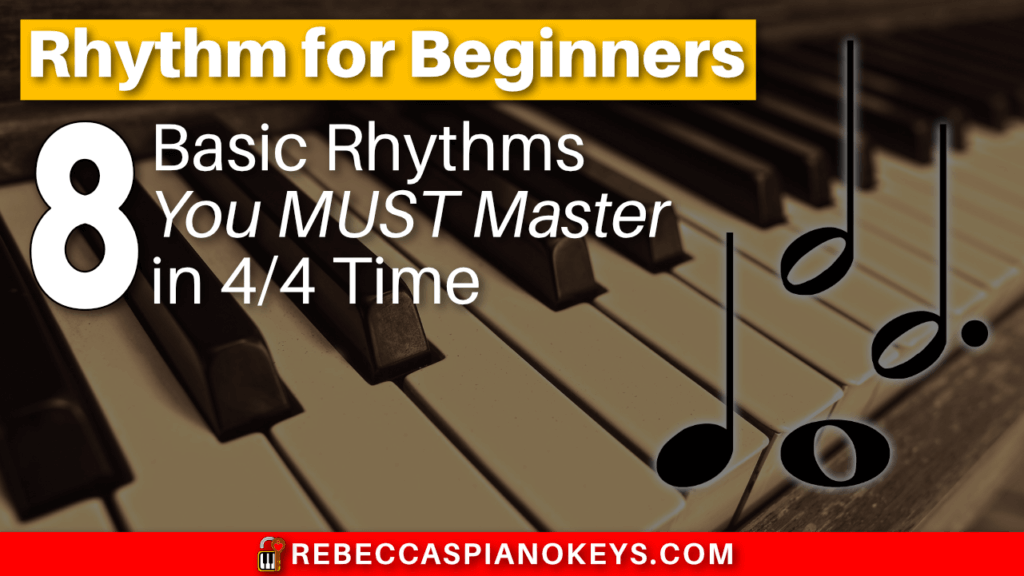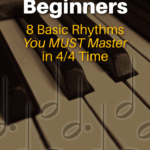Last Updated on June 13, 2022 by Rebecca
Disclosure: Please note that this article contains affiliate links, and that means that I may earn a commission if you buy something through my links. Read my full disclaimer here.
The biggest “secret” to successful piano learning is to stop trying to do everything at once. By separating your tasks into smaller chunks, you can drastically minimize your struggles and frustrations.
In this case, I'm talking about rhythms (although the same logic applies to many other musical scenarios as well).
If you can master a variety of rhythms–if you can internalize how they feel and remember what they look like in musical notation–it will make your experience as a piano learner so much easier and more enjoyable!
And it can be so helpful to work on mastering rhythms in a context that doesn't involve reading pitches at the same time.

No time to read? Pin me for later!
The 4 Note Values Every Beginner Should Master First
The first 4 note values every beginning piano learner should learn first are: the quarter note (crochet), the half note (minim), the dotted half note (dotted minim), and the whole note (semibreve).
*UK terms are provided in brackets for my friends across the pond!
In any time signature where the bottom number is a 4, the note values are as follows:
- quarter note = 1 beat
- half note = 2 beats
- dotted half note = 3 beats
- whole note = 4 beats

These values will change when you learn other time signatures where the number on the bottom is not a 4 (like 6/8 time for example), but as a beginner, you should get really comfortable with the basic 4/4, 2/4, and 3/4 time signatures first.
A Note on Eighth Notes (Quavers)
Modern method books seem to be introducing 8th notes later and later.
Yes, it's true that you should be very comfortable with notes that represent full beats before you start working with notes that break the beats into fractions.
But with a lot of modern method books, it seems like students don't end up learning 8th notes until their 3rd or 4th year of study.
In my opinion, this is just ridiculous.
I've yet to teach a student who couldn't handle 8th notes much earlier than this (unless they started lessons as preschoolers).
How to Count Beats
There are 4 different ways to count beats in music: relative to measures, relative to individual notes, and with words.
Each of these 3 ways is effective.
And by the way… you should be counting these out loud while you play or clap the rhythms.
Counting Beats Relative to Measures
The way I learned as a child was to count beats relative to the measure. So if you're in 4/4 time, you count 1-2-3-4, regardless of where the notes lie within the measure.

Counting Beats Relative to Individual Notes
In more recent years, it's become common for students to learn to count relative to individual notes first, then graduate up to counting relative to the measure.
For example, in a measure with 2 half notes, the student would count 1-2-1-2 rather than 1-2-3-4. Then, after the student has developed confidence with note values, they would transition and learn to count relative to the measure (1-2-3-4).

Counting Beats with Words Relative to Measures
Another way to count rhythm is to use words. This strategy is particularly useful for helping students learn to feel the appropriate meter of a given time signature.
MUSIC TERMINOLOGY
Meter (or metre): the pattern of stressed and unstressed beats within a measure of music. Each time signature has its own meter.
In this strategy, each beat is “counted” with the syllable of a given word, rather than a number.
For example, in 4/4 time, rather than counting 1-2-3-4, the student would count wa-ter-mel-on.
The same word is used for all measures, regardless of where the notes lie in the measure, because the pattern of stressed and unstressed syllables in the word watermelon helps you to feel the natural meter of 4/4 time.

Counting with Words Relative to Individual Notes
In terms of feeling the natural meter of a time signature, this technique is not as effective as the “watermelon” technique mentioned above.
But it can be helpful if you struggle to maintain a steady beat when counting with numbers.
In this case, words are used to help you feel the pattern of long and short notes. Sometimes each note gets it's own word, and sometimes 2 or more notes are represented by individual syllables from a longer word.

The trouble with this technique is that it's subjective. Different people pronounce words/phrases differently, and which syllables are longer or shorter in a person's speech pattern varies.
So it's important that you find words/phrases that work for you, because phrases that feel right to others might not feel right for you, and vice versa.
8 Basic Rhythms in 4/4 Time
So what are the 8 most basic rhythms every beginning student should learn in 4/4 time?
Start with rhythms that involve only quarter notes, half notes, dotted half notes, and whole notes. For now, just leave out rests and any note values smaller than a quarter note.
This limits the possible combinations to only 8 basic rhythms.
I've created a package of free printable rhythm cards you can use to practice these 8 basic rhythms in 4/4 time, using only quarter notes, half notes, dotted half notes, and whole notes.
Included in the rhythm package are 4 versions of the rhythm cards:
- Unlabeled Beats
- Beats Labeled Relative to Measures
- Beats Labeled Relative to Individual Notes
- Beats Labeled with Words Relative to Notes
Other tools to help you practice reading rhythms:
Looking for resources that are already printed and ready to go?
The Benefits of Mastering Rhythms
No matter what your goals are as a musician, mastering rhythms will be a great help to you. It can help you with 3 different goals: reading sheet music, composing and improvising your own music, and arranging pop songs.
Goal 1: Reading Sheet Music
If your goal is to read sheet music, being able to recognize notated rhythms and instantly know exactly how they are supposed to feel will take half the work out of your note reading process.
You won't have to worry so much about the rhythm, so you'll be free to focus on getting the pitches right and playing with proper technique.
Goal 2: Composing and Improvising Your Own Music
Mastering new rhythms is like building your vocabulary.
As a writer, the larger your vocabulary, the easier it is to express exactly what you want to say because you have more words in mind to choose from.
This means:
- There's a greater likelihood that you'll be able to think of the word you need.
- You'll be able to find the most specific word possible to describe what you want to say. For example, you'll be able to say your main character was “distraught” rather than “very sad.” It paints a better picture.
- Your writing will be more interesting because it will have greater variety and less redundancy.
It's the same with composing and improvising music. The larger your rhythmic vocabulary, the better your composing and improvising will be. You can't pull a rhythm out of your heart if you don't have it in your heart in the first place!
Also, if you know what these rhythms look like in notation, it will be much easier for you to notate your musical creations (if you choose to do so).
Goal 3: Arranging Pop Songs
Personally, I find notating the rhythm is the most difficult part of creating arrangements of pop songs. It's very easy for me to learn to play a pop song by ear, but figuring out how to actually notate what I'm playing is a bit more of a process.
But if you already know what certain rhythms look like in notation, it makes the process a lot easier. You'll be able to feel what you're playing, then have a visual connection to what it looks like in notation.



Great details here! Love the explanation and pictures to detail each method for counting. I will definitely use your ideas with some of my piano students! Thanks.
Thanks, Madison! I’m glad you found it helpful! 🙂
I just joined and already I’m impressed. Thank you
Thanks, Sandy! So glad you’re enjoying my resources! 🙂